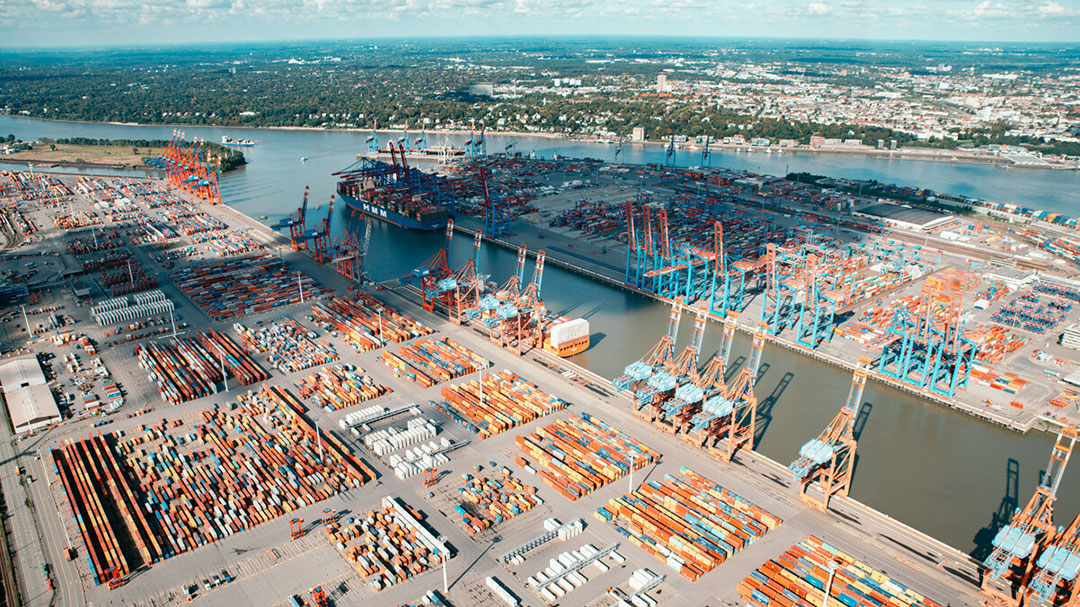
Timo Jann
In the first half of 2025, around 4.2 million TEU were handled in the Port of Hamburg – an increase of approximately 10 per cent compared to the same period last year, when 3.8 million TEU were handled. Jens Meier, CEO of the Hamburg Port Authority (HPA), sees the main reasons for this in the significant increase in trade with China, Malaysia and Singapore, while traffic to and from the USA slumped by 19 per cent between January and June 2025.
Meier is convinced that the Port of Hamburg benefits from its good connections to the hinterland. This is a major advantage over Rotterdam, where ships are currently queuing up for clearance. “We have excellent coordination between ships, rail and road here,” the HPA CEO continued. He is pleased that new road connection projects are planned, including the A 26 motorway, the new Köhlbrand Bridge and the port cross-link between the A 1 and A 7 motorways.
Hamburg is building the port of the future
Numerous measures have already been initiated to further improve transhipment processes. These were presented by Senator for Economic Affairs Melanie Leonhard (SPD) together with Meier to selected journalists during a barge tour. The “Tägliche Hafenbericht” (THB) was also on board.
Thanks to the extended turning circle from 480 to 600 metres, it will only take 40 minutes instead of the previous 90 to bring a large container ship into the Parkhafen. The turning circle is one of the building blocks of the so-called western expansion. By capping the headland at the Petroleum Harbour and filling in a large part of the harbour basin, the Eurogate terminal will gain two new berths and 38 hectares of space for container handling. Terminal managing director Tim Schmonsees expects these measures to result in an increase in transhipment of 2 million TEU. Leonhard hopes that this will provide an opportunity to compete for new lines and bring cargo to Hamburg.
The additional space will be used to push ahead with the automation of transhipment. Once the new technology is up and running, the existing fleet will also be adapted. Future container gantry cranes will be remote-controlled, and van carriers will be replaced by automated vehicles. Those responsible estimate that the necessary infrastructure and superstructure will cost around 1.1 billion euros. Everything should be completed in about ten years.
“The western expansion is of great importance for the entire Port of Hamburg,” says Senator Leonhard. The handling of shipping traffic also depends on interaction with the encounter box, which was implemented as part of the fairway adjustment. This will allow the time window for the arrival and departure of large freighters to be extended. “The aim is to process the ships quickly,” says Meier.
New logistics areas in the Steinwerder area
Further port areas are to be created in the Steinwerder-Süd area, not far from the cruise terminal. A special pontoon is currently being used to fill the ground under water with the aid of a sprinkler system. A usable area of around 26 hectares is expected. According to the economic authorities, the site to be filled is located between Travehafen and Ellerholzhafen and has “excellent road, rail and water connections”. Meier reports that a decision on who will invest in the site is to be made in 2026/2027. Meier: “There are a wide variety of interested parties.”
What is certain is that it will be used for water-related purposes. The port authority and politicians have already agreed that the area is accessible to ships with a draught of 10.80 metres and is too valuable to leave unused.
Further expansion of shore power facilities
The HPA will continue to invest in shore power connections at all berths for seagoing and inland vessels in the coming years. From 2027, cruise ships in Hamburg will be obliged to use the electricity supply.
This year, three shore power connections will be built at the Altenwerder container terminal and two at the Cruise Centre Hafencity. By 2030, power connections are also to be available at O’Swaldkai, the South-West Terminal and Athabaskakai, and the systems at Eurogate, the Tollerort terminal and Burchardkai are to be upgraded. The berths for inland waterway vessels at the Rethe water steps, Eversween and Holthusenkai are to be connected this year and next. “Shore power is also intended to be the springboard for fully electric propulsion and emission-free shipping,” said Meier.
Renovation of quay walls
There are quay walls stretching for around 43 kilometres in the Port of Hamburg. Only 8 kilometres of these are less than 30 years old. 14 per cent of the structures are over 100 years old, many of them dilapidated. According to Melanie Leonhard, it would cost around 50 million euros to renovate 500 metres of quay wall. “So we need a high three-digit million euro amount for the acute need,” says the senator. This is also a major issue for the city. The preservation and renovation of the structures also serve to protect many areas of the port from flooding.
As soon as the HPA, which commissions specialist companies to carry out the work, can offer renovated areas to users, demand will be high, according to Meier. Part of the enormous investment costs will then be recouped through rental payments, he says.
Against the backdrop of the great need to invest more in the construction and modernisation of naval vessels due to the changed global threat situation, the renovation of the pier known as “Steinwerder Kai” at Blohm + Voss is currently a priority.
Do you have a special request?
Contact us if you would like to learn more about the efficiency of German logistics!